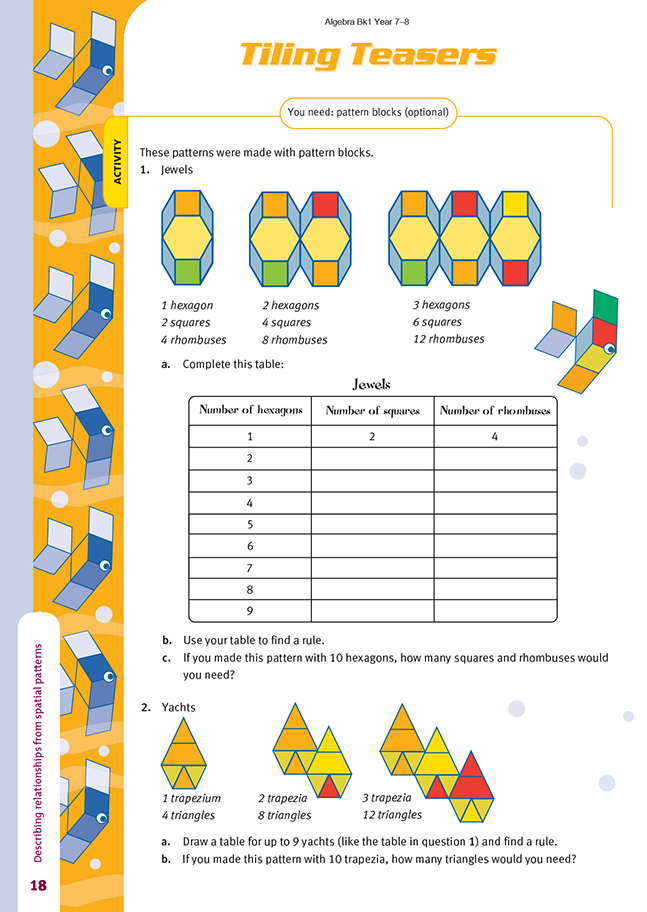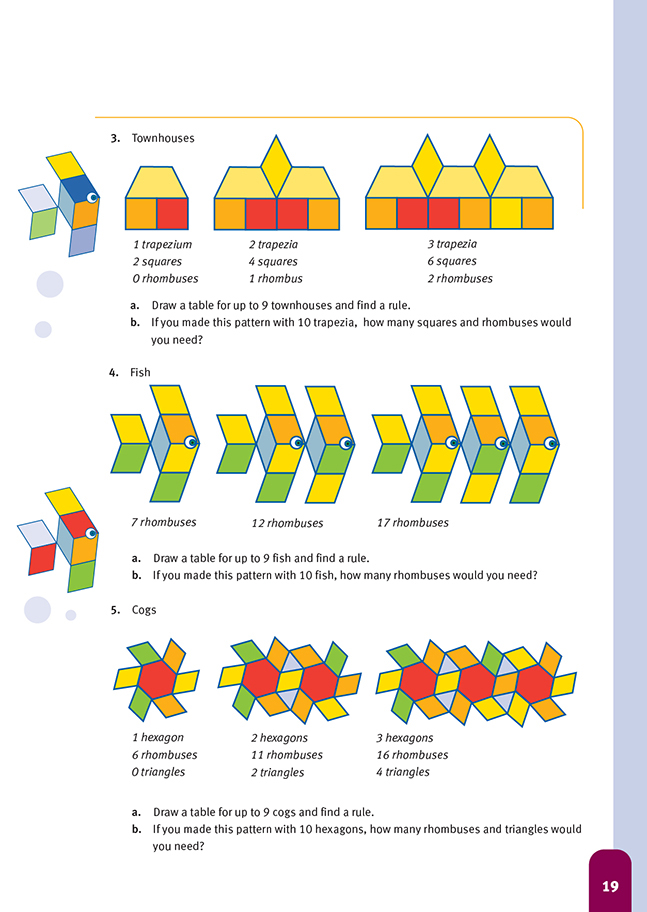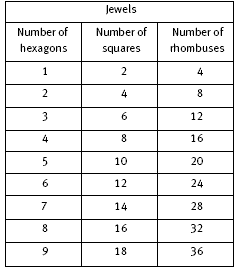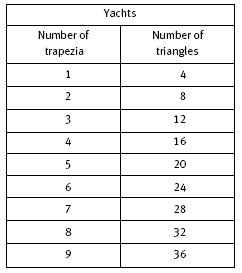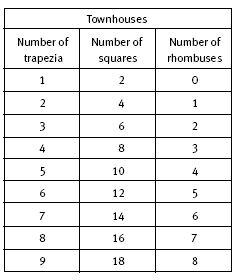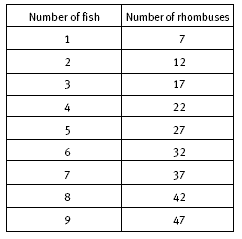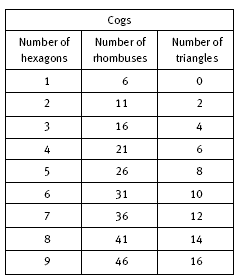This is a level 3 algebra strand link activity from the Figure It Out series.
A PDF of the student activity is included.
Click on the image to enlarge it. Click again to close. Download PDF (181 KB)
use a table to complete a pattern
use a table to find a rule for a geometric pattern
FIO, Link, Algebra, Book One, Tiling Teasers, pages 18- 19
pattern blocks (optional)
In this activity, students consider patterns built from basic geometric units. While the first questions ask the students to extend patterns in a straightforward way, later questions ask them to consider a pattern in which new elements are introduced or where only part of the initial shape is repeated.
In question 1, the students count the number of squares and rhombuses (shapes with 4 equal sides that in this case are not squares) for jewels with 1, 2, and 3 hexagons and enter their results in a table. They look for patterns in the table and write a rule for each pattern. Having completed the table, the students then use the rules to predict the number of squares and rhombuses for 10 hexagons. The patterns here produce simple rules: the number of squares is 2 times the number of hexagons, and the number of rhombuses is 4 times the number of hexagons.
As earlier, some students may be ready to write these rules using algebraic symbols. So for n hexagons: s = 2 x n and r = 4 x n, where s is the number of squares and r is the number of rhombuses. These rules are usually written more simply as s = 2n and r = 4n. The symbols s and r stand for the number of squares and the number of rhombuses respectively, not for the actual square and rhombus shapes. Note that r = 2s is a third rule, this time linking the number of rhombuses with the number of squares. This rule can be expressed in words as “The number of rhombuses is 2 times the number of squares.”
In question 2, each yacht has 1 trapezium (a 4-sided shape or quadrilateral with 1 pair of parallel sides). Each yacht also has 4 triangles. So a rule is: the number of triangles is 4 times the number of trapezia (or yachts). In algebraic notation, we can write n = 4 x t, or better, n = 4t, where n is the number of triangles and t is the number of trapezia (or yachts).
In question 3, the number of squares is 2 times the number of trapezia (or townhouses), and the number of rhombuses is the number of trapezia minus 1. These can be expressed algebraically as s = 2t and r = t – 1. Here, s stands for the number of squares, r stands for the number of rhombuses, and t stands for the number
of trapezia (or townhouses).
In question 4, the number of rhombuses is 5 times the number of fish plus 2. This can be expressed algebraically as r = 5 x f + 2 or r = 5f + 2, where r stands for the number of rhombuses and f stands for the number of fish, although this is likely to prove challenging for many students. They may instead come up with a rule something like the following: 1 fish needs 7 rhombuses, and each additional fish adds 5 rhombuses. Using this rule, they could then predict that 10 fish would need 7 + 9 x 5 = 52 rhombuses.
In question 5, the number of rhombuses is 5 times the number of hexagons plus 1, and the number of triangles is 2 times the number of hexagons minus 2. These rules can be expressed respectively as r = 5n + 1 and t = 2n – 2, where r stands for the number of rhombuses, n stands for the number of hexagons, and t stands for the number of triangles.
Once again, such rules will elude some students. Equally acceptable is a rule such as: the first cog needs 1 hexagon, 6 rhombuses, and 0 triangles; each additional cog adds 1 hexagon, 5 rhombuses, and 2 triangles. Using this rule to calculate the number of rhombuses and triangles for 10 cogs or hexagons, we find:
rhombuses: 6 + 9 x 5 = 51
triangles: 0 + 9 x 2 = 18.
Answers to Activity
1. a.
b. A rule is: 2 times the number of hexagons gives the number of squares, and 2 times the number of squares or 4 times the number of hexagons gives the number of rhombuses.
c. 20 squares and 40 rhombuses
2. a.
A rule is: the number of triangles is 4 times the number of trapezia.
b. 40 triangles
3. a.
Rules may vary. A possible rule is: the number of squares is found by multiplying the number of trapezia by 2, and the number of rhombuses is found by taking 1 off the number of trapezia.
b. 20 squares and 9 rhombuses
4. a.
A rule is: the number of rhombuses is 5 times the number of fish plus 2, or each new fish (after the first) adds 5 rhombuses.
b. 52 rhombuses
5. a.
A rule is: 5 times the number of hexagons plus 1 gives the number of rhombuses, and 2 times the number of hexagons minus 2 gives the number of triangles.
b. 51 rhombuses and 18 triangles
